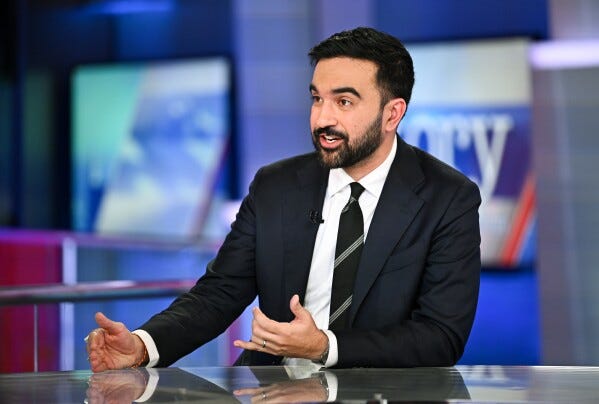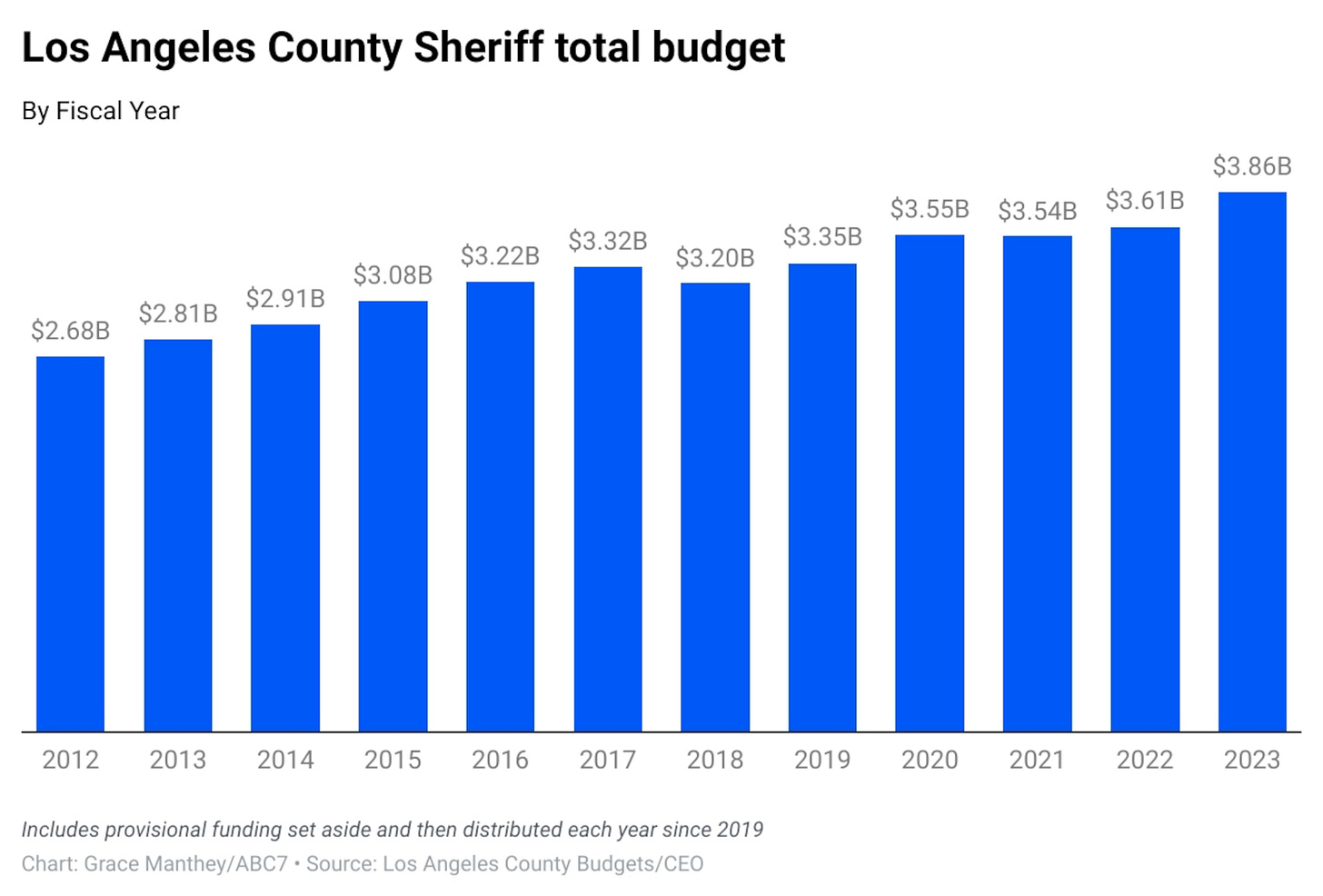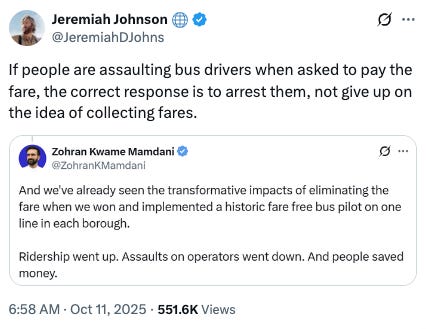Here's What (Almost) Everyone Gets Wrong About Public Safety
The philosophy behind a cop-first public safety program is wrong. Here's a better one.
There are two acceptable approaches to public safety in American politics. The first is to Get Tough On Crime by hiring more cops and letting them take the gloves off, The Shield-style. The second is to Get Smart on Crime by hiring more cops and promising modest reforms to remove ‘the few bad apples’ who give the otherwise impeccable police a bad name. Any policy that suggests a new approach, or, Heaven forbid, doesn’t want to hire more cops, is discarded as a fantasy. This dynamic is currently playing out in the New York City Mayoral Race. The Republican candidate, Curtis Silwa, wants to hire seven thousand more police officers and bring back the NYPD’s Street Crime Units, which have been disbanded and rebranded multiple times due to chronic civil rights violations.1 Disgraced former governor and independent centrist candidate Andrew Cuomo has taken the ‘smart’ approach, promising to hire more NYPD officers while increasing oversight to ensure the police ‘respect citizens’ civil rights.’ However, for the first time I can remember in a nationally-watched election, an alternative approach to public safety is being suggested. Inspired by New York pilot programs and existing, under-reported alternative public safety plans, Zohran Mamdani — the undisputed, heavyweight champion of the NYC Democratic mayoral primary — is offering voters a new, more effective way of keeping his future constituents safe.

I find debates about policing particularly frustrating, given that everyone has deluded themselves about the last five years. Republicans will claim the police were defunded in 2020, which led to entire cities being ‘burnt down’ by Black Lives Matter, Antifa, Hamas, lesbians, and other members of the League of Doom. Centrists in the Democratic Party will claim #Defund was the Party’s platform, and therefore, responsible for their poor electoral performance. Despite the white-people white-knuckling their pearls, the truth is that American police were never defunded, and almost no national candidates suggested it in their platforms. Police departments in major American cities have had their funding increased in the years after the murder of George Floyd, not decreased.2 And yet, right-wing and centrist politicians claim crime is out of control, and therefore, we need to hire more cops. If crime is as big a problem in New York City as Cuomo and Silwa claim, that proves there’s a flaw in their theory of public safety. The New York Police Department’s total 2023 budget (fiscal year and central allocations such as pensions) was $10.9 billion, which is larger than both Ukraine’s pre-Russia-Ukraine War defense budget ($6.9B) and Finland’s current defense budget ($7.54B).345 As for manpower, the NYPD’s 35,000 uniformed officers and 15,000 civilian staff are more than enough.6 The NYPD is twice as big as Norway’s military and half the size of the British army. Excluding civilian staff, there are 3.9 cops per 1,000 New Yorkers. London has about four cops per 1,000 residents, but that’s only if you combine the Metropolitan and City of London police. Given that the NYPD is fully-staffed and well-funded, the logical question to cop-happy politicians is, “If cops are the key to public safety, why is crime as bad as you say? Isn’t it time to try something different?” If I spend almost $11 billion on my water bill to water my garden, and the plants still don’t grow, I doubt another $5 billion in utilities will do the trick. It’s probably a good time to try new soil or move the plants into sunlight.

This is to say nothing about the downsides of American policing. In New York, the police department’s overtime is a drain on the city budget. In the last decade, it’s grown by 52% up to $2.22 billion, almost a fifth of the NYPD’s total expenditure.7 As a cherry on top, taxpayers paid $310 million to victims of police misconduct in 2024, a recent high.89 With the current policing model costing New York City billions of unnecessary spending and, by admission of the most cop-happy politicians in the mayoral race, still not reducing crime enough, I find the pushback to alternative public safety programs to be dogmatic and unserious. Clearly, the current model has serious flaws. So, why the hostility to trying something new? Take the response to Mamdani’s free bus program, for example.
Over the weekend, the DSA-backed candidate highlighted how his free bus pilot program decreased assaults on bus drivers. Putting aside economic critiques of the program (which I find unconvincing, as the world’s 8th-largest economy can handle it), fewer assaults should be good news to everyone. Or, so I naively thought. Jeremiah Johnson, the founder of the Center for New Liberalism, which calls for “alternative public safety programs” and “better public transportation,” criticized Mamdani’s plan.
Jeremiah’s response is interesting. He doesn’t make an argument that the reduced crime isn’t worth the lost fares from revenue, nor does he dispute that free buses reduce crime. Instead, he argues that these pre-crime assaulters should be arrested, rather than eliminating the cause of the assault altogether. This isn’t a practical argument, but a philosophical one that perfectly summarizes the difference between how the left and the rest of the political spectrum approach crime and public safety.
To most centrists and rightists, public safety increases with each Bad Guy arrested. In their view, the act of incarceration is both the means and the end. In Jeremiah’s mind, it’s better to let bus drivers be assaulted so the perpetrators can be detained — the rate of incarceration is correlated to how “safe” the streets are. But to Mamdani and much of the left, crime is frequently, but not always, a situational outcome. That situation might be poverty, addiction, or even forcing people to interact with a city employee, leading to confrontations. I believe this is the superior mindset to have when approaching public safety, because by changing the situation, the motivating factor of criminality is eliminated. Unlike the Center for New Liberalism’s suggestion that we punish the perpetrator after the crime, in Mamdani’s approach, the crime never happens. This creates an unequivocally safer (and less expensive) city than the police-first model. The pilot program Mamdani referenced only had a few bus routes from September 2023 to 2024, and assaults on bus drivers dropped 38.9%. This is compared to every other New York City bus, which was suffering from assaults despite the NYPD having a larger force than NATO members.10 And it’s not just New York. A similar program in Kansas City found that toll-free buses increased rider safety for all participants. Bus drivers were called to respond to aggressive riders 39% less, and incidents per 100,000 riders fell by 17%. Participants felt safer, with 80% saying $0 fare made the bus safer.11
If New York City, or America, for that matter, wants safer buses, streets, and cities, the solution is to study and eliminate the sources of crime. While this example focuses on public transportation, the same philosophy is the guiding core of Mamdani’s public safety platform, the only one of the four on-ballot candidates that doesn’t call for hiring more cops. His proposed Department of Community Safety draws heavily on the success of Baltimore and Chicago (which I’ll write about shortly), looking to interrupt violence before it begins with increased mental health professionals and crisis responders. Jeremiah Johnson and other popular pundits pride themselves on being realistic problem solvers. But on the topic of public safety (and many others, in my opinion), they’re boasting about the strict dogmatism and groupthink that traps them in a political fantasy that a safer society can be reached by hiring a thousand more cops. And if that doesn’t work, we’ll just hire another thousand. And another thousand. And another. And another…
As the socialist Albert Einstein said, the definition of insanity is doing the same thing over and over and expecting different results. I understand this is a big ask, but I’d like America to be slightly less insane. Public safety seems like a good place to start.
If you enjoyed this article, please click the ❤️ and subscribe to receive emails and support my work. Thanks!
In Solidarity — Joe
https://www.nytimes.com/2023/06/05/nyregion/nypd-anti-crime-units-training-tactics.html
https://www.goodmorningamerica.com/news/story/defunding-claims-police-funding-increased-us-cities-91511971
https://cbcny.org/research/six-fast-facts-about-nypds-preliminary-fy2023-budget
https://www.macrotrends.net/datasets/global-metrics/countries/ukr/ukraine/military-spending-defense-budget
defmin.fi/en/topical/press_releases_and_news/press_release_archive/2024/defence_budget_emphasises_defence_capabilities_and_nato_membership.14781.news
https://www.police1.com/nypd-laser-focused-on-recruiting-as-staggering-number-of-officers-depart
https://comptroller.nyc.gov/reports/overtime%20-overview/
https://legalaidnyc.org/news/nypd-misconduct-lawsuits-over-205-million-2024/
https://comptroller.nyc.gov/newsroom/comptroller-landers-new-dashboard-tracks-city-claims-city-paid-nearly-2b-in-settlements-last-fiscal-year/
https://www.thenation.com/article/society/new-york-city-bus-free-fare/
https://reasonstobecheerful.world/kansas-city-fare-free-transit-safer/



I think people believe the more cops = less crime fallacy is because they associate police presence with safety (eg, deterrence). And if you believe in the theories of crime that argue crime is a moral and/or opportunistic choice, then I get why people would think this.
I think this is why the broken windows model, flaws and all, became so popular; people need to perceive there is no disorder in order to believe it’s not happening.
Not saying it’s right, but I understand.
What is overlooked by having massive police forces, or those with qualified immunity, and the 'thin blue line' code of silence, is that the police themselves become a criminal gang. One that is taught 'warrior cop' mentality, that there is us, and everyone else we must intimidate and control. Corruption, rape, murder, domestic violence, all common issues. As are 'special units' some that dote on violence and literally put notches on their guns.
This is rooted in how the US police forces were constituted first from the state constitutions that required males between 14 and 50 to own a firearm and participate in slave patrols, then after reconstruction the KKK and the police were often the same, as the lyrics say 'some of those who work forces are the same who burn crosses.'
More recently it is the outright militarization of US police forces as a domestic pacification and occupation force as many came out of the GWOT as did the equipment, tactics, and intelligence methods against our own population.
Crime often comes from the failure of civil society to provide; it is lower in societies that have lower levels of inequality and higher levels of happiness. What provides those are no mystery, but doing so in the US is against the individualistic and capitalistic values that keep being perpetuated as national myth, when in reality all progress was a function of social investment and communitarianism.
Non police response to social needs work, one of the first in the country was the Eugene Oregon CAHOOTS program created in 1989, it became a model for other cities to craft their own, Portland Oregon has its Street Response program. Olympia, Phoenix, Albuquerque, and Denver all created programs inspired by it. Mental health, social worker, medic led units to deal with issues that often police respond poorly to when confronted with someone in crisis, or a need they are unprepared to fulfill.